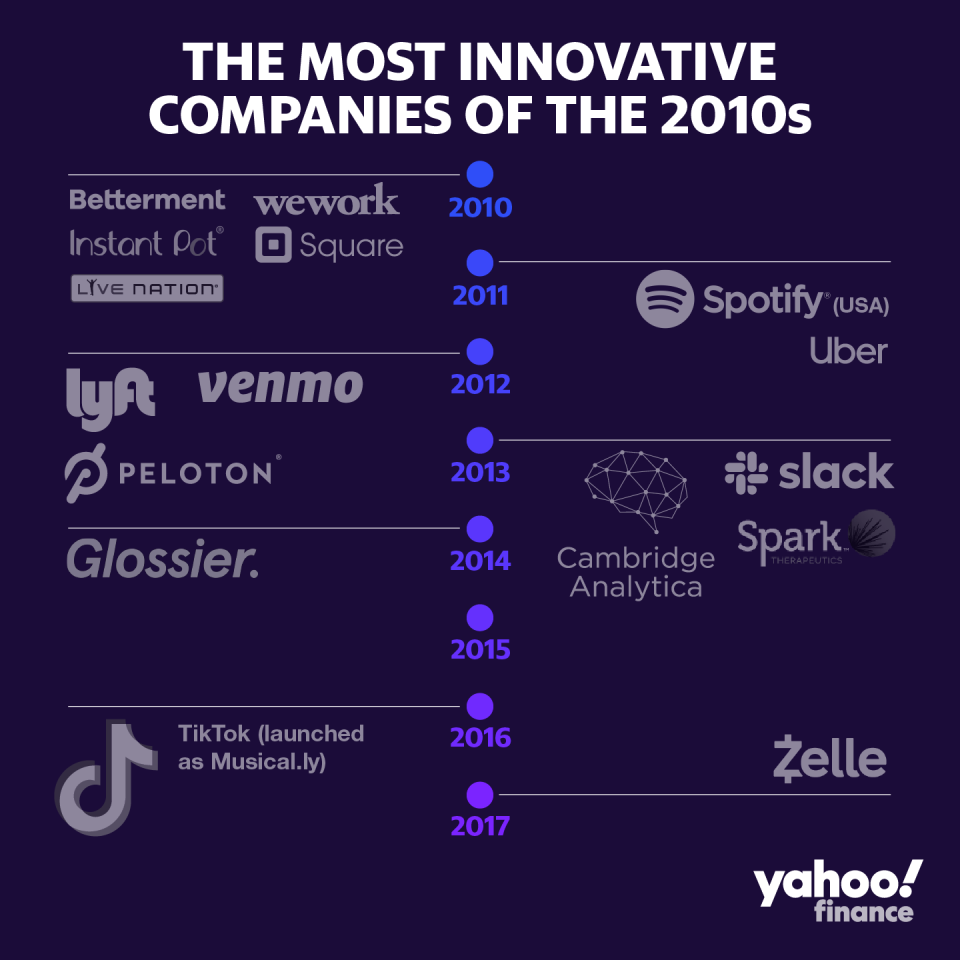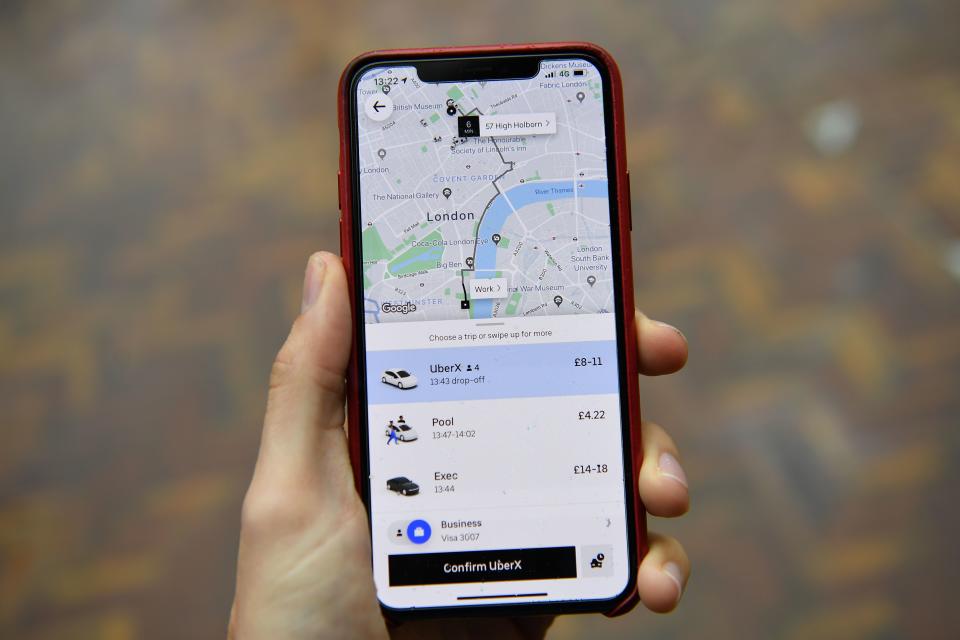The 16 most innovative new companies of the 2010s
The past decade was dominated by a cadre of companies that we all know very well. As Mark Cuban summed it up in an email, with his trademark brevity, the most influential companies were “all social media companies and then Netflix.”
It’s true that the 2010s were predominantly shaped by the rise of the phone — which used to be called the smartphone — putting powerful internet-connected computers with amazing cameras in our pockets.
Thanks to Apple, Google, Samsung, LG, wireless internet providers, and cloud providers like Amazon Web Services and Microsoft’s Azure, a layer of connectivity was sewn into the fabric of our society.
The most innovative and influential companies of the last 10 years were older standbys and tech companies that emerged in the previous decade, including the four mentioned above. Facebook, Disney, Amazon, Microsoft, and Tesla changed our culture and how we live, and showed glimpses of what the future might look like.
But while the 2010s were, to some extent, dominated by tech legacy names, other companies came forward — and took advantage of the new always-connected public.

Instagram - 2010
Twitter, Facebook, and YouTube constantly find themselves in political imbroglios. Instagram, on the other hand, has steered away from most of that controversy while reshaping trends, e-commerce, and the whole idea of influencers. Purchased in 2012 by Facebook for $1 billion, Instagram was the first mobile-first social media app and its image-first positioning brought it widespread success it still enjoys today.
Betterment - 2010
Betterment, one of the first so-called robo-advisors, popularized the notion that you don’t need to pay a professional to help you invest — an automated service could do it. As Joshua Brown, a financial advisor with Ritholtz Wealth Management told Yahoo Finance, it’s one of the companies that has had a profound impact on all the businesses in its space. Today, many big-name investment brokerages, like Charles Schwab and Vanguard, have followed Betterment’s lead, adding robo-advisory services.
Live Nation - 2010
Since its merger with Ticketmaster in 2010, Live Nation, which organizes concerts, sells tickets, and more, has made an impact on live entertainment, from music festivals to regular concerts. It’s also added technology to a fairly stale environment, integrating social media and RFID functionality like wristbands into the concert experience.
WeWork - 2010
It’s not easy to call WeWork a success, unless your name is Adam Neumann and your bank account has a $1.7 billion exit package. But the company did something really interesting: it figured out a way to be a middleman for growing businesses that need workspace but also need flexibility. While it hasn’t worked yet on a large scale, the idea — at least in certain locations — shows yet another way that being a good middleman can be leveraged.

Instant Pot - 2010
It’s not easy to innovate in the kitchen and create a new must-have device, but Canadian inventor Robert Wang did just that. The Instant Pot, however, managed to do just that, becoming a best-selling item on Amazon’s Prime Day this year, selling 300,000 in 36 hours. The family of multi-cookers that cost well under $100 can slow cook, pressure cook, steam, sauté, cook rice, and much more has an active community of users on social media — a key aspect of its success.
Square - 2010
Square’s first innovation came from its white card-reader that attached to an iPad or an iPhone, allowing a seller at a farmer’s market to finally accept purchases made by credit card. Since then, the company has disrupted strong incumbent players to give small businesses the tools and payment functionality of an advanced tech company.
Spotify (USA) - 2011
Streaming music app Spotify came to the U.S. in 2011 after launching in Europe at the end of the 2000s. It completely changed the music industry, the latest disruptor to come. Just like Napster and iTunes before it, Spotify shifted the model from music-owning to music-renting — for $9.99 a month, you could stream as much music as you wanted. Spotify torpedoed the iTunes Store and forced Apple to shift its business model to Apple Music and changed how music is discovered, promoted, and gets popular.

Uber - 2011 / Lyft - 2012
Uber and Lyft are the perfect example of how new technology is built on the shoulders of the technology that came before it in two different ways. First, with a connected population that has GPS in their pockets, the companies were able to take advantage of the technology to “change the way we travel,” Barry Ritholtz, CEO of Ritholtz Wealth Management, said in an email.
At the same time, Uber and Lyft capitalized on the emergence of the sharing economy: their innovation was letting people take advantage of extra time and their cars if they wanted to — even if it hasn’t always been a success for drivers and profitable for the companies. As Nicolaj Siggelkow, an economics professor at Wharton, put it, these companies have been successful “crowd orchestrators,” bringing in consumers as suppliers.
Venmo - 2012
For whatever reason, retail banking has had difficulty with innovation. Until Venmo rolled out to the public in 2012, transferring money between friends quickly was not easy and usually required having cash on hand. The company, which is owned by PayPal, completely changed how money is transferred and allowed instant settling of debts. Its success, and that of Square’s Cash App (2013) pushed the big banks (JPMorgan Chase, Bank of America and others) to perfect their own money-transfer platform called Zelle that launched in 2017.
Peloton - 2012
Peloton took SoulCycle’s spinning-class success and added hardware that people could buy, scaling the experience to anyone with a few spare square feet and a few thousand to spend on a bike. Peloton, which went public in September, innovated not only the spin class but the way that people can work out at home — still with a sense of community. The next decade will doubtless feature similar home-but-not-alone methods of exercising.

Spark Therapeutics - 2013
Spark Therapeutics is a biotech company that was the first gene-editing therapy to change a hereditary condition — in this case, blindness. You might not have heard of this company, but Wharton’s Siggelkow, who is also co-director of the Mack Institute for Innovation Management, told Yahoo Finance that he sees these advances as major innovations — even if we’re not seeing them at scale yet. Being able to repair genetic mutations and affect conditions like blindness would have an astounding impact on society.
Cambridge Analytica - 2013
The infamous digital political consulting firm Cambridge Analytica innovated elections and political campaigns, exploiting weaknesses in newer platforms like Facebook and a public that was exposed to its influence to hyper-target political content.
“They may have helped determine the winner of the 2016 US presidential election,” Ritholtz said. “Nothing is bigger than that!” Problematic as it may be, there’s no doubt Cambridge Analytica innovated data and analysis in its space of elections and its influence will be lasting. Just ask Mark Zuckerberg.
Slack - 2013
Part social network, part communication tool, Slack’s technology – meant to facilitate workplace collaboration – has had a profound impact on workplace culture and productivity, or lack thereof, in some cases. It has single-handedly wrestled away control of workplace communication from email in many cases, and integrated itself with other workplace functions like Google’s GSuite and more. Slack, which went public in June, has 105,000 paying customers, and 50 of them pay at least $1 million a year in recurring revenue.

Glossier - 2014
Direct-to-consumer was a big trend of the 2010s, as brands like Warby Parker turned incumbent businesses on their heads by cutting out the middleman and presenting a clean user experience. Susan Etlinger, industry analyst at Altimeter, pointed to Glossier, which sells makeup and skincare products and is incredibly popular with Gen Z and millennials, as a brand that successfully harnessed direct-to-consumer through social media platforms and the idea of brand experiences.
Glossier’s innovation goes past the Warby Parker model of direct-to-consumer eyeglass frames and actively harnesses the community of consumers, showing the power of dialogue in modern e-commerce. In fact, Glossier began with content and then went into products, a shift that will likely be repeated in the future.
TikTok (launched as Musical.ly) - 2016
Innovation might be a strong word when it comes to TikTok, which lets users create short lip-sync videos, originally launched as Musical.ly in 2016. But any company that manages to do the impossible — break into the non-niche social media space dominated by a few players — deserves to make the list. Similar to Vine (which went defunct in 2016), the Chinese app and platform is already having a massive impact on popular culture. It’s not only a meme factory, but it’s also proving to be a new ground where musicians and influencers are born.
-
Ethan Wolff-Mann is a writer at Yahoo Finance focusing on consumer issues, personal finance, retail, airlines, and more. Follow him on Twitter @ewolffmann.
More End-of-the-Decade stories:
Why the 2010s were a decade divided
The stock market's biggest winners and losers of the past decade
20 businesses that died in the 2010s
Read the latest financial and business news from Yahoo Finance
Follow Yahoo Finance on Twitter, Facebook, Instagram, Flipboard, LinkedIn, YouTube, and reddit.